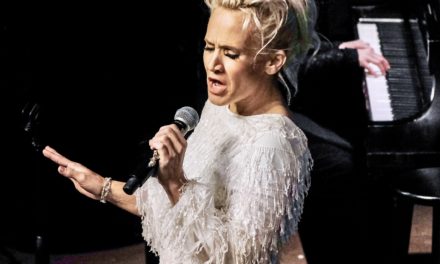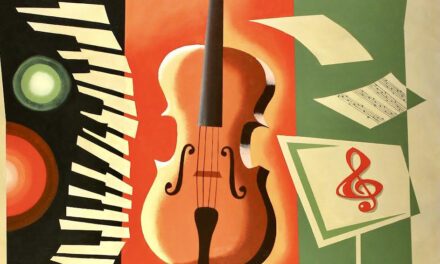By Daniel Buckwalter
(#commonmanatthesymphony)
How do colors speak to you?
This was the question posed Thursday night by Francesco Lecce-Chong and the Eugene Symphony Orchestra he expertly leads. The answer Lecce-Chong and the symphony gave included a kaleidoscope of greens, yellows and golds mixed with fiery reds and oranges and soft blues as an added touch.
The colors flowed through six short, well-known pieces and two lesser-known symphonies by composer Alexander Scriabin, using digital displays projected onto an enormous canvas that surrounded the orchestra, and a “radiance orb” that was lowered for the first of Scriabin’s two pieces. And that doesn’t include the University of Oregon Chamber Choir and its appearance in the aisles with each member holding a small orb that blazed with its own colors.
All of it bathed the packed house at Hult Center’s Silva Concert Hall. It was, to be sure, an enchanting and mesmerizing sight.
The production, more than a year in the making, left me asking a question in return, however: How much color is too much color?
Fine, color me a minimalist, if you will, but elements of Thursday night’s splashy light show were overwhelming. This was especially true during the orb’s entrance for Scriabin’s Prometheus: Poem of Fire (Symphony No. 5).
There was Christopher Taylor as guest pianist, Jeremy Schropp on the light organ, orb play (I don’t know what else to call it) by Light at Play, digital projections by Harmonic Laboratory and the UO Chamber Choir with its own small orbs.
It would have been enough to keep up with the musicians, which is what I wanted to do. The light show that accompanied the piece crowded out the music, I think. It was sensory overload, and it left me closing my eyes for moments during the piece so I could hear the symphony.
Technology is wonderful, yes. All of us use it and depend on it. I often wonder, though, if we get caught up with the bells and whistles of technology and use them simply for the sake of using them.
Sometimes, simple is better.
Minimalist that I am, though, I was taken by the lighter digital productions for the six short pieces on Thursday night, most of them done by Lane County-area students.
In the first half of the program, I was struck by the digital artistry of Rimona Livie (North Eugene High School) and her work with Claude Debussy’s Clair de Lune. On the canvas surrounding the orchestra, it told the story of how the ocean’s mammals converge and form the moon. It was wonderfully done.
Right after intermission, there was the digital production of Felix Neelman (University of Oregon). He had red and green dancers gracing the canvas to Felix Mendelssohn’s Scherzo from A Midsummer Night’s Dream.
Most of all, I enjoyed the second Scriabin piece the symphony played (The Poem of Ecstasy, Symphony No. 4), which also was the symphony’s final selection of the night.
There was no color to it, no special effects. It was simply the Eugene Symphony Orchestra doing what it does best, playing the heart out of the music in front of it. It was beautiful. This, to my mind, is why patrons flock to the Hult Center for the Performing Arts — and why even more people should.
The next chance to do that is Sunday, April 28, at Hult Center’s Soreng Theater for An Afternoon with Beethoven. Performance times are 1:30 p.m. and 3:30 p.m.













I had a similar reaction.
I was left feeling visually assaulted at certain points of the concert – as if someone were shining a bright and confusingly colorful flashlight in my eyes.
I put some thoughts about the concert here: https://twitter.com/AmyAdamsOregon/status/1119688865579560961
(Speaking of that, I’m typing this comment in light gray on a gradient background and literally cannot see what I’m typing for a good deal of this sentence…you might want to consider making a small change to the commenting interface. apologies for any typos I simply cant see.)